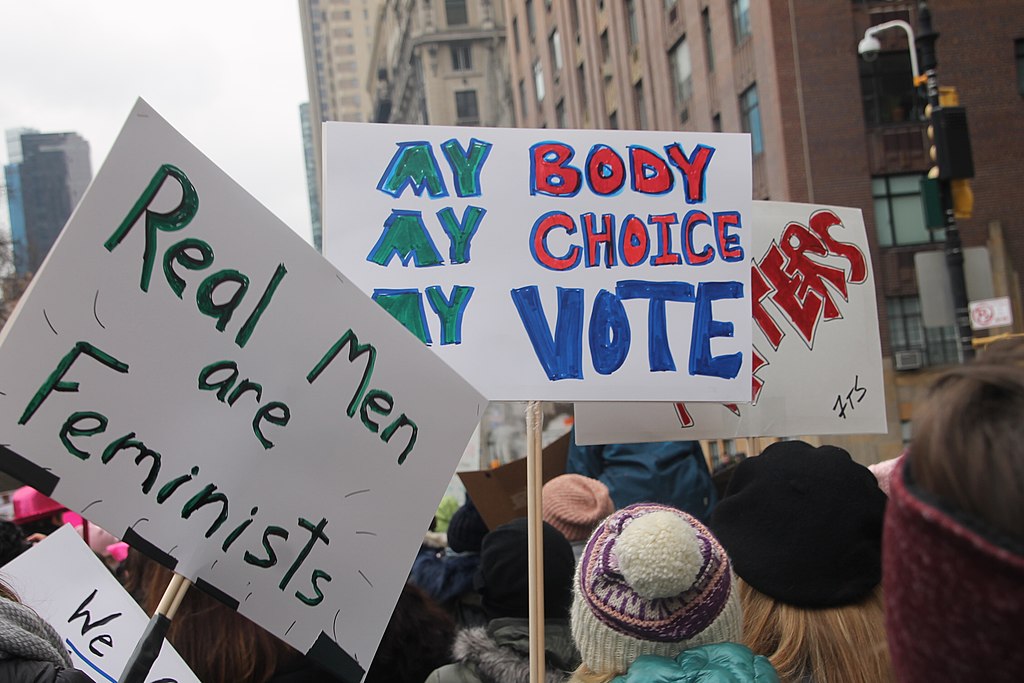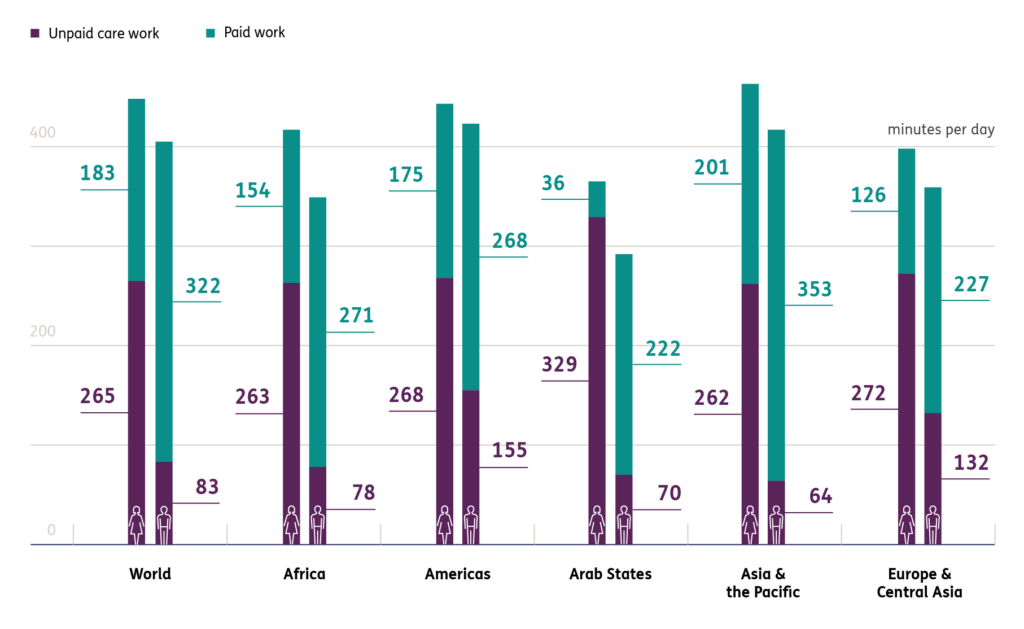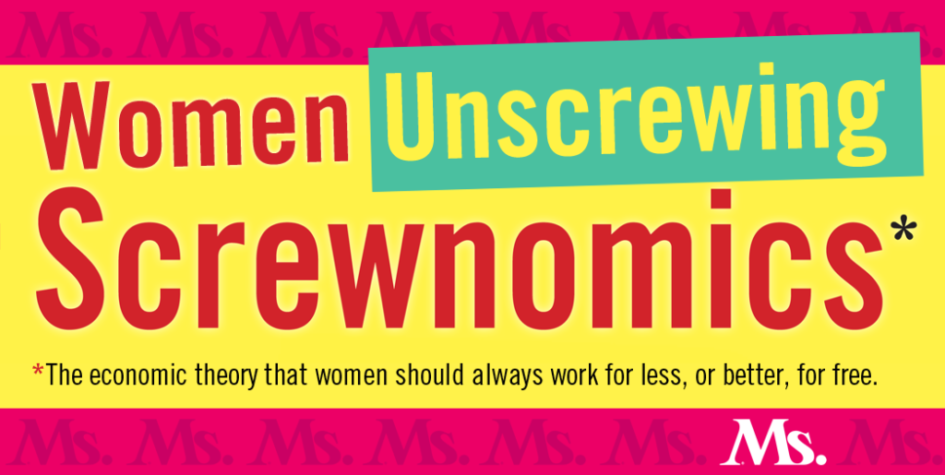1/12/2022 by Rickey Gard Diamond
It’s time to talk about women’s economics with attitude. It’s time to laugh at what is often absurd and call out what is dangerous. By focusing on voices not typically part of mainstream man-to-man economic discourse, Women Unscrewing Screwnomics will bring you news of hopeful and practical changes and celebrate an economy waged as life—not as war.
For centuries under common law, a daughter or a wife was the property of the family father or husband or, upon his death, the closest relative with a penis. Whatever was theirs was his, but most importantly the family patriarch oversaw her most valuable asset: her womb. In earliest medical thought, a womb was fertile ground in need of guarding and fences to make property rights clearer, and she to be plowed and planted with seed—quite literally, semen.
Without her bearing the next generation, a man had no successor for his business or his patch of land. No successor meant the end of a fortune, a castle, a pasture, a hut. Heads of households controlled mating and whether a child would live in the household or not. Though rarely done, a woman’s divorcing her spouse resulted in his custody of the children—which were his, by law, the product of his seed, grown in his womb property, legally fenced-in.

We thought such laws and cultural metaphors were behind us. Women’s rights under U.S. jurisprudence seemed well-established after more than a century of legal wrangling. Women like Elizabeth Cady Stanton first fought for a married woman’s right to inherit and own property, won initially in 1858. It laid the groundwork that implied women themselves were more than property, if not fully citizens yet.
Little by little, women won the right to an education, the right to keep her own paycheck or have a profession, the right to sit on a jury, the right to vote in elections, and by 1974, the right to open a bank account without a male co-signer.
But now the cowboys of Texas have put a bounty on women’s wombs. They’ve reclaimed property rights by building a time-fence around women who seek an abortion, shutting the gate on her freedom of choice at six weeks, and calling on a posse, any posse, any cowpoke, to sue her abortion providers.
Mississippi and 25 other states stand ready to round up unwilling American women with what are called trigger laws. A herd of legal experts predict that this year the Supreme Court may well set aside 50 years of precedent set by one of its most famous rulings, Roe v. Wade. That precedent admitted that a woman’s unwanted pregnancy could potentially result in a “distressful life and future.”
A later case, 1992’s Casey v. Planned Parenthood, even stated that abortion rights were needed if women were to be equal participants in the nation’s economic and social life. The stakes are women’s civil rights as citizens, surely, but also financial ones. With the USDA setting the cost of raising a child born in 2015 to college age at $233,610, trigger and womb-fence laws will trap many women in what is called the “informal economy.” It’s a nicer phrase than poverty.
Ironically, U.S. cowboy setbacks came nearly hand-in-hand with a call to honor the economy’s “informal” workers around the world. Darren Walker, the president of Ford Foundation, and Sally Roever, the international coordinator at Women in Informal Employment, wrote a mid-June op-ed in Timemagazine, comparing the world’s informal workers to yesteryear’s coal miners. The majority of 2 billion such workers worldwide are women—still about 20 percent of workers here in the US; 58 percent of women globally.
What is this “informal” work? It is work performed without state protections or regulations. It is ad hoc arrangements of trade and barter, self-employment, and work for cash under the table. It’s whatever a woman and her family can conjure to survive.
Walker and Roether wrote:
“Informal work is the essential service that billions of people give to a world that barely notices. These are workers who survive outside the social and labor protections that employees in the mainstream economy enjoy, doing countless invisible jobs. … Their workplaces are inside homes or out on the streets and sidewalks; they are everywhere and yet they are overlooked, forgotten, ignored.”
The International Labour Organization’s 109th Conference happened that same month and the op-ed writers expected the ILO to “demand [that] international governments and employer representatives chart a global economic recovery with the informal workforce at the center.” This sounds righteous—yet as they admitted, “The weak regulations and eroding labor protections of the globalized economy have contributed to grotesque inequality and concentration of wealth and the mass migrations of people desperate for economic security.”
What is “informal” work? It is work performed without state protections or regulations. It is ad hoc arrangements of trade and barter, self-employment, and work for cash under the table. It’s whatever a woman and her family can conjure to survive.
The pandemic revealed gaps in our supply-chains worldwide, and the special vulnerabilities of working women. Perhaps that’s why President Biden addressed the ILO’s annual conference this year, only the third president to do so. He vowed commitment to building a global economic agenda shaped by workers and rooted in the protection of workers’ rights. The trouble is ILO’s speeches and policy recommendations won’t become real until governments and transnational corporations agree to them.

The AFL-CIO, which works with the ILO, is calling for a new social contract for all workers, says Cathy Feingold. This may take a while since the ILO, first founded in 1919, took a century to approve in 2019 the first international treaty to eliminate gender-based violence and harassment on-the-job. Feingold sounds hopeful, reporting dozens of countries now working on this. Yet gender-based violence and harassment in the home, or violence and harassment by the state itself, isn’t part of their vision.
“Informal” labor is an economic word for work in the private world of our homes and neighborhoods, not as privileged as the traditionally male public world of “formal” job market work that pays taxes and, in exchange, receives state protections. Time, attention and skill are needed in both worlds of work, but the real difference between them is money, gender and race. These differences are only amplified in a global system dominated by mostly white male corporate wealth and global corruption.
Time, attention and skill are needed in both worlds of work, but the real difference between them is money, gender and race.
Even by ILO’s international standards, the very real labor of reproduction, or the time and skill required to provision a family and maintain a home isn’t on the table for even informal discussion. If you work in your home mending clothing for cash, under the table, that’s informal; if you are a mother cooking for your kids the food you’ve grown on a patch of ground, that’s invisible. If you become an American mother before you are ready, I mean before you can come up with a plan to raise $233,610 in the formal work world, you’ll be forced to work however you can—like 20 percent of women workers do in this country.
One bright light in all of this is women’s rising power within U.S. unions, a real change. Their dynamic leadership was noted by Bloomberg News. This is especially true in those female-dominated realms of education and healthcare. The Institute for Women’s Policy Research reports that while women, overall, continue to make only 80 percent of what male workers do in the formal work world, unionized women make 84 percent.
Now imagine if the women at the National Welfare Rights Union, who have long fought for wages for housework and mothering were joined by their other union sisters. Together, they might tear down a fake wall between informal and formal work—the time of our lives—and those imposed fences claiming women’s wombs as state property.

Leave a Reply